
Region
Uttarakhand | India
Duration
7 Days
Max Altitude
12000 Ft.
Trekking Km
43 KM
Grade
Easy to Moderate
Help & Support
+91 7351523841 info@trekthehimalayas.com10:00 hrs to 18:00 hrs | GMT +5:30
Monday - Saturday | Sunday Closed
12500 /Person
- May-2024
- June-2024
- September-2024
- October-2024
- November-2024
- +5% GST (goods and services tax)
- Services Sankari to Sankari
- Addons
-
Insurance is Mandatory.
-
Non-Indian rates are slightly higher. Trek coordinator will provide balance payment link post-booking.
- Get insurance through us or elsewhere. If not through us, email for a refund after booking.
-
Cancellation 4 or more days before the start of the trip results in a 100% cash refund.
-
Cancellation less than 4 days from the start of the trip results in no refund.
-
Transportation Dehradun to Sankri & retun is optional
-
Choose add-ons during booking. If missed, log in and add them later
-
Book transportation at least 10 days before the trek.
-
Cancellation 4 or more days before the start of the trip results in a 100% cash refund.
-
Cancellation less than 4 days from the start of the trip results in a 50% cash refund.
-
Cancellation after the trip date does not qualify for a refund.
-
Backpack offload is optional
-
Choose add-ons during booking. If missed, log in and add them later.
-
Book off-load at least 10 days before the trek.
-
For offline bookings at the base camp, a convenience fee of Rs. 2000 applies.
-
Cancellations made before the trip date will receive a full refund.
Insurance 245
Transport 1600
Offload 1500
For more information. Please complete this form.
Help & Support
+91 991 772 4737info@trekthehimalayas.com 10:00 hrs to 18:00 hrs | GMT +5:30
Monday - Saturday | Sunday Closed
Overview
Trek Name: Har Ki Doon Trek
Days: 7
Adventure Type: Trekking
Base Camp: Sankri
Season:Summer | Autumn |
Month:April | May | June | September | October | November |
Country: India
Altitude: 12000 Ft.
Grade: Easy to Moderate
Rail Head: Dehradun
Stay: Camping (Twin sharing) & Hotel/Guesthouse
Food: Meals while on trek & at Hotel/Guesthouse (Veg & Eggs)
Location: Uttarakhand
Distance: 43 Km.
Trail Type: Circle trail | Camping in various locations, starting and ending at the same point.
AirPort: Jolly Grant Airport, which is 28 km away from Dehradun
Highlights:
- +5% GST (goods and services tax)
- Services Sankari to Sankari
Why Har Ki Doon Is A Must-Do Trek?
A trekker’s delight, the Har Ki Doon Trek is a stairway to heaven that will make you fall for its beauty. The thing that makes it an alluring trek is its accessibility both in summer as well as the winter season. Har Ki Dun Valley is situated at the western flank of Garhwal in the Uttarkashi district and is very popular with trekkers as well as climbers. It is a lovely walk to the Har Ki Dun valley with fascinating views of the Swargarohini group of peaks. Har Ki Dun catchment area is a major source of the Yamuna River System and the main source of the largest tributary of Yamuna.
Har Ki Dun Trek takes you through some of the most charismatic alpine meadows and pine forests which is a treat to the eyes. During winters the snow-covered trails of Har Ki Dun Trek looks mesmerizing as and when the sun tries to peep behind the clouds. One of the oldest Treks in the Himalayas, known as the Valley of Gods, some believe Har ki doon is the same route taken by the Pandavas in the Mahabharata on their ascent to heaven. Swargarohini—the snow peak, the vision of which dominates the Har Ki Doon Trek bears a legacy of the mythical stairway to heaven and this trek gives you a true
.webp)
Who Can Participate
-
Age; 12 years +.
-
First timers can apply; previous trekking experience is more appreciated.
-
The climber must be fit and have sufficient stamina to cover 5 km of distance in 30 minutes without stress.
-
The climber should be able to carry a 10-15 kg backpack.
-
Pulse rate at rest must be in between (60 to 90 beats per minute)
-
Blood Pressure Reading must be in between (DIASTOLIC 70 – 90, SYSTOLIC 100 - 140 mm Hg)
-
Respiratory rate at rest must be in between (12 to 20 breaths per minute)
-
Should not have Liver and kidney issues
-
Should not have Diabetes Mellitus, Bronchial Asthma, Heart problems, Hypertension etc
-
No pacemaker implant
-
People with the Sinus issues, Epilepsy please contact to trek coordinator before booking the trek
-
If your BMI is not normal, Please contact our Trek coordinator before Trek booking.
Medical & Disclaimer Form (Mandatory Documents) Click here to download Medical & Disclaimer Form
- Government Employees can avail the benefit of Special Casual Leave (SCL) when you join us for a trekking expedition. As per the rules of the Pay Commission, Special Casual Leave can be availed for up to 30 days in a calendar year for trekking/mountaineering expeditions through a registered organization. Trek The Himalayas is a registered adventure tour operator by Indian Mountaineering Foundation (IMF) and Ministry Of Tourism (MOT)
- Trekkers have to apply for leave at least 20 days before trek departure date,
- This service is exclusive to Indian government employees and is applicable only for treks within India.
- Do mail at info@trekthehimalayas to apply and mention your booked trek date and trek name.
- Junior trekkers (below 15 years) should have a company of parents/guardians.
- Trekkers between 15 to 18 years can come solo with the disclaimer form signed by parent/guardian.
- Medical & Disclaimer Form (Mandatory Documents) Click here to download Medical & Disclaimer Form
Itinerary
Dehradun To Sankri | Start Your Journey Towards A Himalayan Paradise
- 220 km drive by NH 507 - approx 10 hrs.
- Altitude: 1,950 m/ 6,400 ft.
- Last ATM: Purola.
- Small shops available for trekking gears and miscellany.
- BSNL network is erratic.
- Breakfast and lunch excluded, dinner included
- Trekkers will be picked from Dehradun railway station at 6:30 am in a tempo traveller or similar vehicle.
- Transportation Amount is not included in the trek cost.
- Expected arrival in Sankri by 5:00 pm.
- Stay in guesthouse in Sankri.
The first day begins with a 10-hour drive from Dehradun to Sankri. You are expected to reach Dehradun railway station by 6:30 in the morning. To reach on time, you can book an overnight Bus/Train from Delhi to Dehradun ISBT. Sankri is located at a distance of 220 km away from Dehradun and it takes about 10 hrs approximately to cover the distance. You will have an altitude gain of 1950 m.
Passing through Mussoorie- the “Queen of the Hills” and the beautiful Kempty Falls onto Uttarkashi district, we will cross Naugaon, Purola, Mori, and Netwar before finally reaching village Sankri- the first stop on the trek. The road is through and through picturesque with pine tree forests starting on both sides of a road that catches up on a parallel to the course of the river Tons. After Mussoorie the scenery changes vividly, the deep gorges are replaced with pine forests that carry the fresh scent of the pinewood in the air. Stopping at a favorable hour, we will have lunch somewhere by the road at an inn. Reaching Purola, you should get done with important calls and internet usage because hereafter, the connection will get fuzzy. BSNL is the only efficient service available in this zone with limited providers.
The final stretch to Sankri for about 20 km, the drive becomes extremely scenic. A short way before Sankri, we will cross the Govind National Park checkpoint and at about 6 in the evening, the drive will end at Sankri. Sankri is a beautiful Himalayan village that serves as the base camp for many Himalayan treks. The village offers stunning views of Mt. Swargrohini. If you are doing the trek in the winter months, you can expect snow right from Sankri itself. After freshening up at the guest house, you will get sufficient time to explore the market close by. Trekking essentials, garments, and equipment are available at the bazaar in Sankri, in case you need last-minute shopping for the venture ahead.
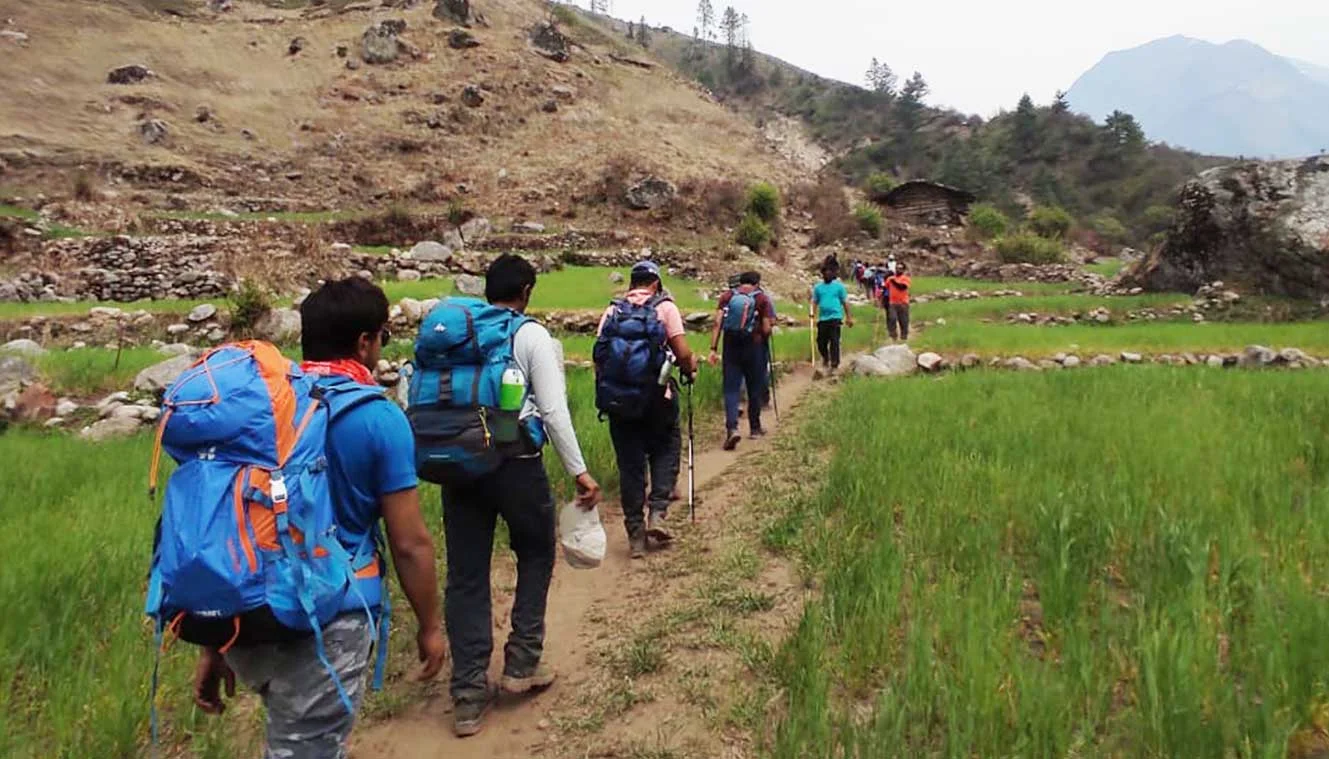
Sankri To Pauni Garaat via Taluka | Witness Step Farming In The Himalayas
- Sankri To Taluka (Drive): 12 km, 1 hr.
- Altitude: Taluka - 2,200 m/ 7,200 ft; Pauni Garaat - 2,500 m/ 8,200 ft.
- Trek Distance: 10 km | Duration: 5-6 hrs.
- Altitude Gain: 550 m/ 1,800 ft.
- Trek Level: Easy level walk and gradual ascent in most parts.
- Packed lunch on the way.
- Springwater points.
- Riverside camping in Govind National Park.
On day 2, we start on our drive from Sankri to Taluka at 7 in the morning. It\'s about an hour drive from Sankri and the short drive will take you through gradually thickening forests and streams cutting through the path over boulders will introduce us to the terrain of our trek closely.
Reaching Taluka, another village of the same lineage found on this trek, trekkers will be invited to collect refreshments before getting started on the hike. Taluka is a small Himalayan village with a few concrete houses. The first lapse is a descent to the banks of the beautiful Tons and keeping the river on the right, the trail enters a level walkthrough forests of conifers until reaching the first cemented bridge. Around 10 minutes into your walk, you will spot the first cemented bridge over a small mountain stream. Crossing the stream, the trail leads up to another wooden bridge, 15 minutes within the trek, where a gentle slope goes down to the waters. Here you can fill your bottle and move ahead. Crossing the Tons River, you can spot beds of vibrant orchids in the spring and summer and this is also a great location to spot Himalayan Wildlife.
The whole way along the river is ideal for photo compositions and provides shade too. We approach the rest point for lunch by the Supin tributary that we crossed before at around 1 in the noon. At a rocky height from the banks of the rivulet is a food shack, one of the many that we are going to find on our trek to the valley. These stores have packaged food and beverages along with delightful hot snacks. In addition to our packed lunch, this will add a different twang of delight to outdoor meals on the move.
Progressing ahead, harvest fields of potato, millet, and maize will fall on the way giving the whole stretch a ranch house feel. The lush green step farming of the Himalayan hamlets will amaze you completely. Pauni Garaat, a green clearing on the banks of Supin at its sprightly best, arrived late in the afternoon as the Sun begins to dip—welcome to the first camp!
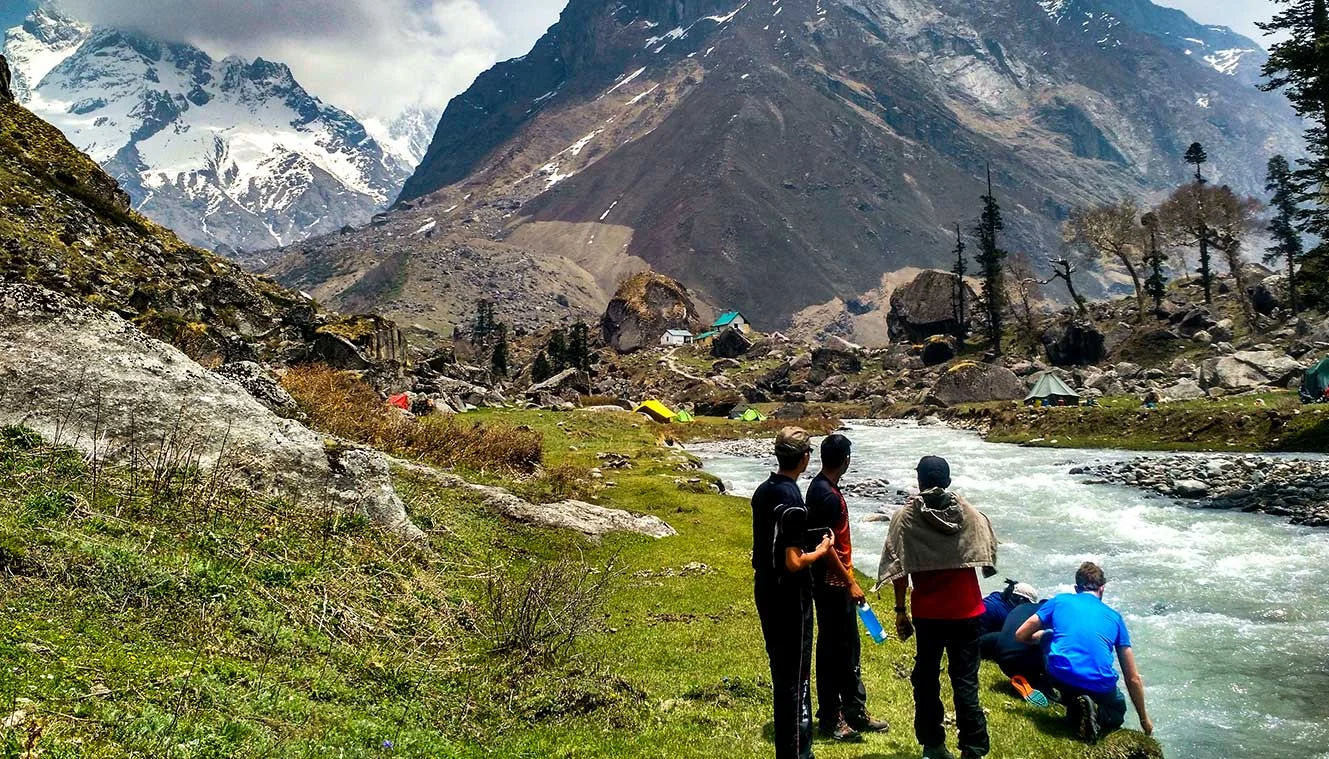
Pauni Garaat To Kalkattiyadhar | Pass By A 300-Year-Old Village
- Altitude: 3,000 m/ 9,850 ft.
- Trek: 8 km | Duration: 5 to 6 hr.
- Altitude Gain: 500 m/ 1,650 ft.
- Packed lunch.
- Springwater points.
- Trek Level: Steeper ascent than last day, but well distributed in level walks and inclines.
- Camp stay in forests overlooking mountains near a food stall.
Pauni Garaat to Kalkattiyadhar covers a distance of 8 km over 6 hours which we start in the early morning at 6 post breakfast. The trail passes through thickets of towering coniferous forests that continue till the village of Seema. Seema village is a cluster of concrete structures and a forest department guest house set by the banks of the Supin River. Osla village is located on the other side of the river. The Seema Bridge is a hanging bridge running over the Supin River with the background of colossal snow-clad mountains, this is an ideal spot to take some beautiful pictures. The trail crosses 3 “garaat” or hydroelectricity run chaffing units which are used by the villagers for separating husks of millet and maize followed by grounding them to flour. With the idyllic vibe retained in the surroundings, the trek proceeds through harvest lands, cattle grazing, and slant-roofed huts used as granary and storage. You will also spot many Amaranth trees and in the monsoon, the trees attain a reddish hue adding a stark contrast to the scenery. About half an hour into the trek it unfolds a grand view of Mt. Bandarpoonch and Swargarohini group of peaks. Right between the forests of cashew nuts and walnuts lies the serene village of Osla. Osla village has interesting mythology attached to it. It is believed that in ancient times, the Osla village had a clan that was faithful and dedicated towards Duryodhan of the Kaurava’s, they were so loyal to him that they built a temple dedicated to him, and to date, they preach Duryodhan in this village. Well, apart from the stories, the village also has a 2000 years old Someshwar Temple and a few houses. The temple has a unique architecture. The villagers are welcoming here and the villagers also dress a certain way that showcases their cultures and traditions. The village has a king that visits once a month and this is when the main pooja is done. After a small chit-chat with the villagers proceed further on the ascend.
From Osla, the trail becomes quite steep and on this incline, you will get fabulous viewpoints to steal glimpses of the Dhauladhar Range out front. Snaky trails to Borasu Pass and Baspa Valley also goes out from here. The high trail winds further down reaching a tabletop green stretch—Kalkattiyadhar. This is the campsite for day 2. Kalkattiyadhar is a beautiful open meadow that presents views of renowned peaks like Bugyal Devsu and Mt. Black Peak. On the left, you will be able to see the Ruinsara Range and the Kedarkantha Summit. Bask in the views, rest well and prepare for the summit the next day.
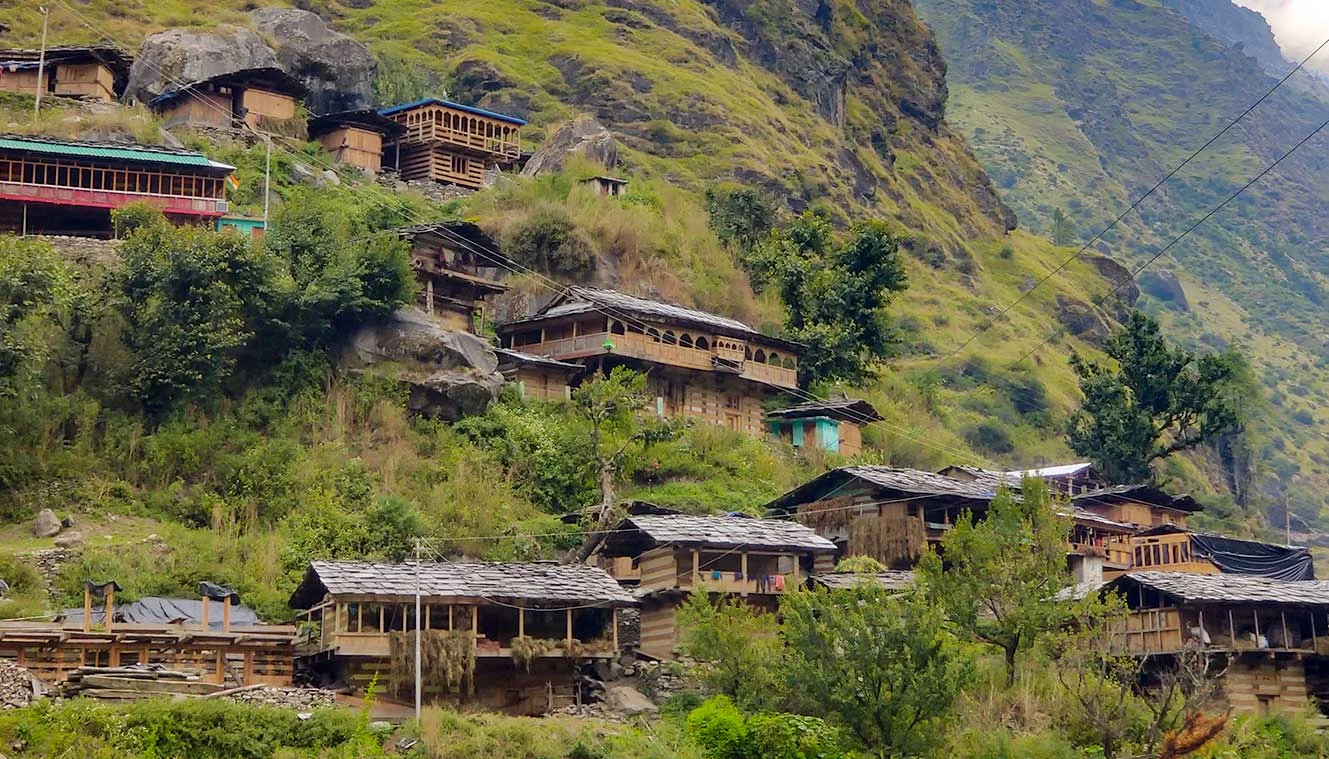
Kalkattiyadhar To Har Ki Doon And Back To Kalkattiyadhar | Day Of Summit
- Altitude: 3,600 m/ 11,800 ft.
- Trek Distance: 10 km | DIstance: 9 hr.
- Packed lunch on the way.
- Springwater points.
- Trek level: relaxed forest walk combined with boulder walk. Mixed gradient with a gradual incline.
- Camp stay in a forest overlooking mountains near a food stall.
- Snow Peaks in view: Swargarohini, Hata Peak, Black Peak.
Today you will start early as compared to other days as it is also the longest day of trekking. We begin the trek right after breakfast. However, as mesmerizing as the views were until today, get ready to encounter something more. The trail will go into the glacier basin having moraines and alpine meadows. Tall pine trees will greet you at every step.
The trail starts out with an ascent above the convergence of the Supin River and the River from the Ruinsara Valley. From this point forward you will start getting beautiful mountain views. The trail is mixed of steep and moderate ascend until the Har Ki Dun valley. Just as you rise high you can see snow patches and frozen waterfalls. In Winter these sections are covered with thick snow. The Har Ki Dun Valley is a heavenly place displaying immense beauty in one sight. The huge peaks of Swargarohini, Hata Peak, Black Peak, etc show their marveling glimpses. The valley is an amazing amalgamation of meadows, frozen streams, coniferous forests, glacier moraines, the backdrop of huge peaks. The trail eventually leads to a point of 45-degree incline, while it is not as steep but in the presence of snow it becomes increasingly difficult. The last leg of the trek climbs alongside a river and through dense forests all the way to the Har Ki Doon summit. From the summit point, you can see spellbinding views of Swargarohini I peak, Hata Peak, and Black Peak. Try to engulf everything. After exploring the valley creating memories for a lifetime we return back to our last campsite at Kalkattiyadhar.
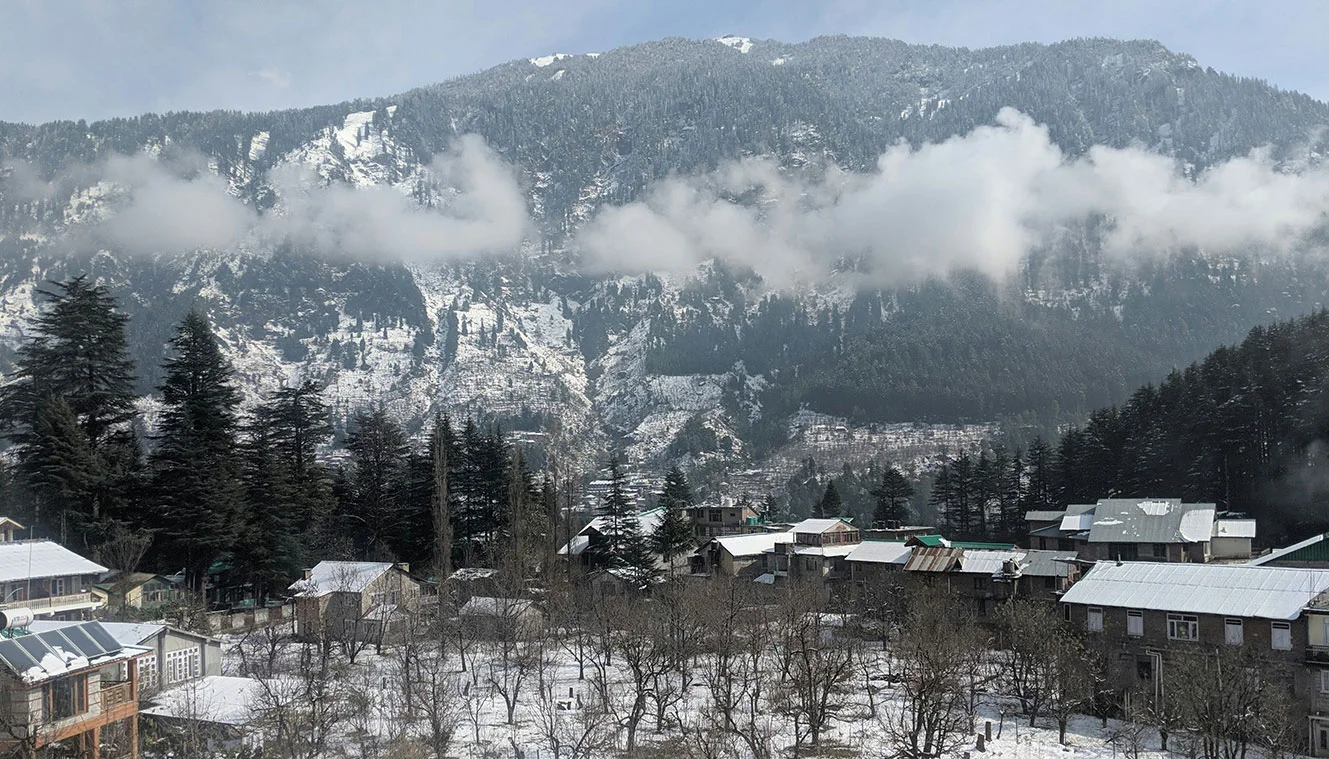
Kalkattiyadhar To Pauni Garaat Via Osla | Retreating Back
- Altitude: 2,500 m/ 8,200 ft.
- Trek Distance: 8 km | Duration: 5 hrs.
- Altitude Loss: 500 m/ 1,650 ft.
- Packed lunch.
- Springwater points.
- Riverside camping in Govind National Park.
From this point on the trek is actually the return journey down. Today we shall retrace the steps through the Osla village to Pauni Garaat. Here is another chance to relive the moments with the peaceful villagers. Say goodbye to them and the stunning sights around you. Wake up early to catch a beautiful sunrise at the Kalkattiyadhar campsite. The morning temperatures are usually on the lower side and in winters it is subzero.
Follow the same trail as of earlier and reach the campsite of Pauni Garaat. The journey down is quite easy as it climbs downhill. Descend gradually all the way to Pauni Garaat. Enjoy your last few moments of nightlife in the mountains. Also, since the trek is not very arduous or time taking today, you can explore the village of Osla today. Pay a visit to the Someshwar temple dedicated to Lord Shiva, there are some beautiful detail carvings on the walls of the temple. Spend the night at the Pauni Garaat campsite.
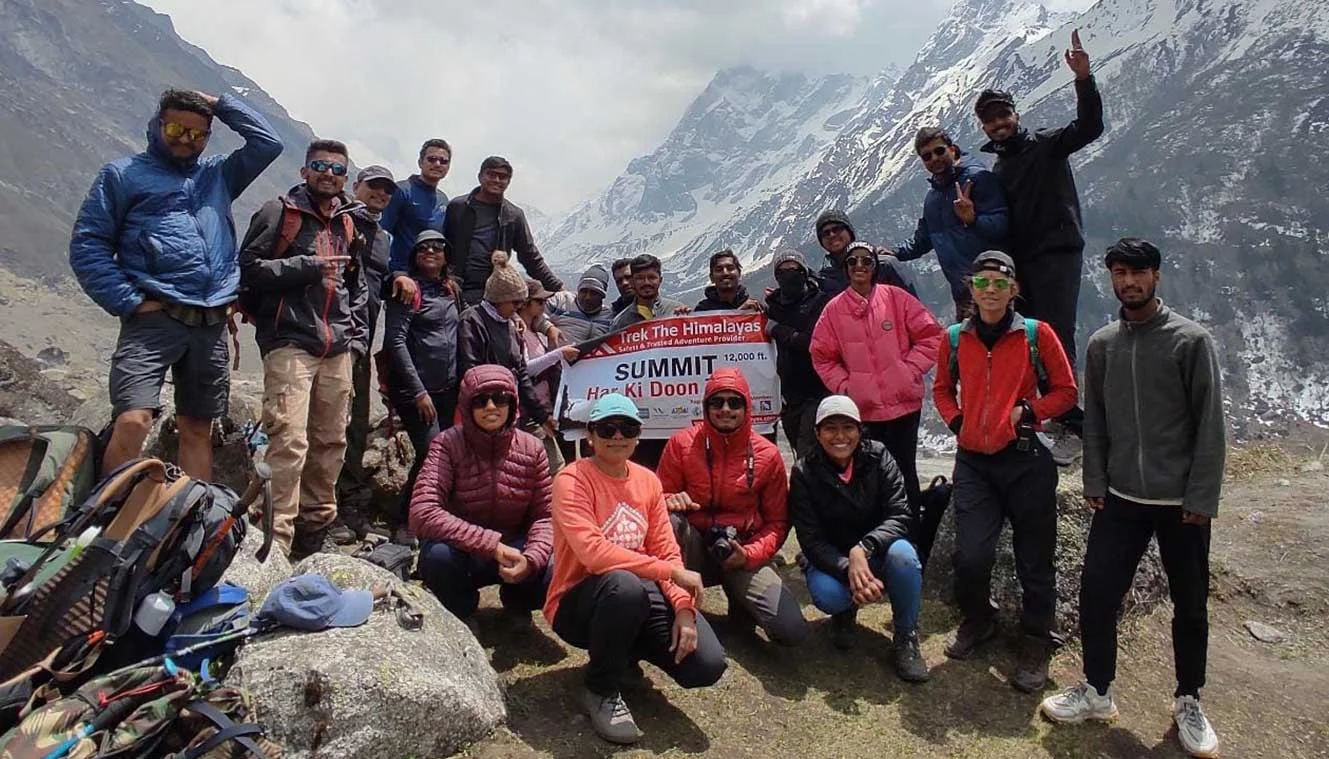
Pauni Garaat To Sankri Via Taluka | Last Day Of Trekking
- Altitude: 1,950 m/ 6,400 ft.
- Trek Distance: 10 km | Duration: 5 hrs
- Drive Distance: 12 km, 1 hr from Taluka to Sankri.
- Packed lunch.
- Springwater points.
- Guesthouse stay.
A 5-hour trek to Taluka sets off this morning, climbing down by the familiar trail, stopping at familiar rest points. After breakfast, we begin the descent towards Taluka along the same path. Beware of “bicchu ghas” alongside the trail, even the slightest touch of this plant can make you feel stinging for 25 minutes. The herb is not poisonous though, as a matter of fact, it is cooked by locals. Soon after a couple of hours of walking, you will find yourself next to the Supin River, the final stretch until Taluka goes over a cemented trail. The car waits at the end of the dirt road to drive back base camp-wards. Pay special attention to descending tactic. Though climbing down accounts for lesser exhaustion, stressing out your soles with big steps is inadvisable. We will arrive at Sankri right at the time for tea.
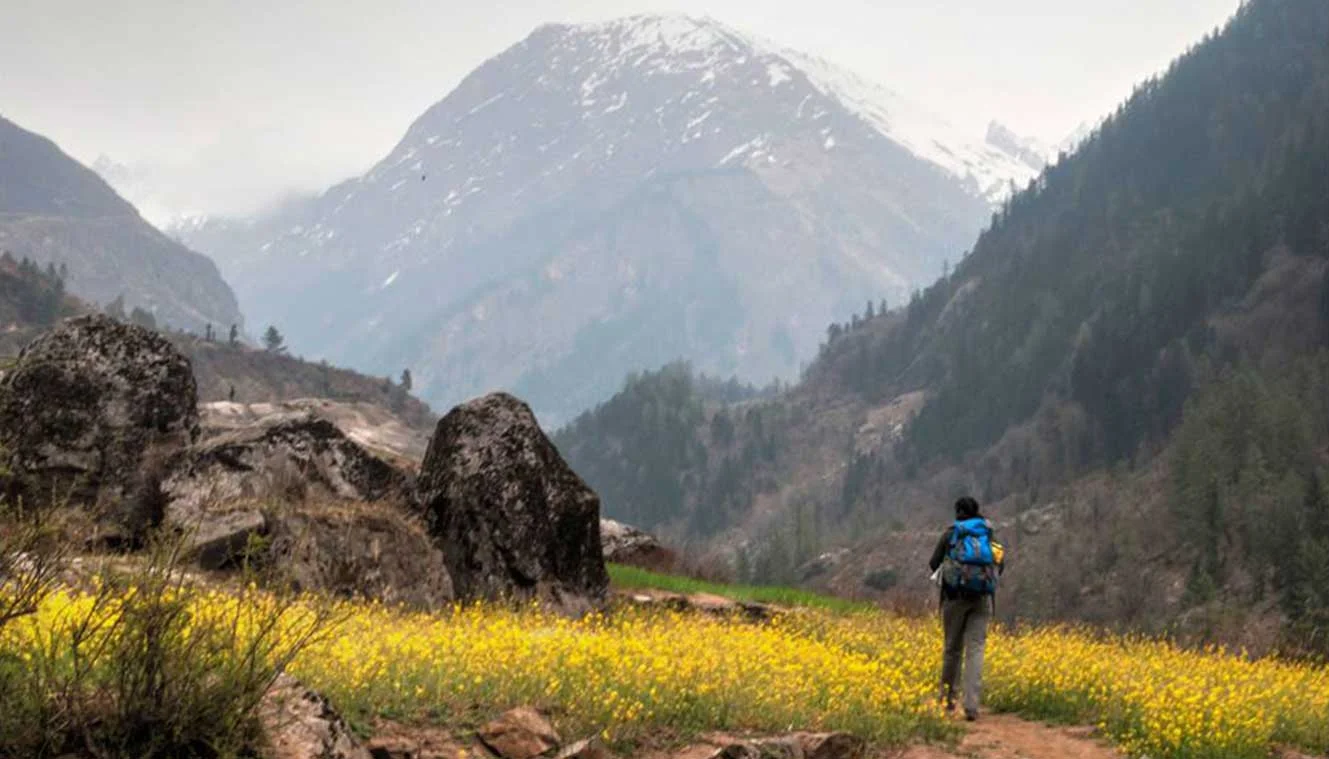
Sankri To Dehradun | Saying Goodbye To The Mountains
- Distance: 220 km | Duration: 10 hrs approx.
- Driving Time: 7 am - 6 pm.
- Breakfast and lunch excluded.
- You will be dropped at Dehradun station in a Tempo Traveller or a similar vehicle.
Today we bid adieu to the mountains with lots of memories in our hearts. The journey concludes with the 10-hour drive from Sankri to Dehradun. Breakfast and lunch will be on the way. Reaching time at Dehradun station will be 6 pm, suitable for an overnight journey to Delhi. To be7 on the safer side, arrange your journey from Dehradun Bus Stand by 9 PM. This will help account for delays if any.
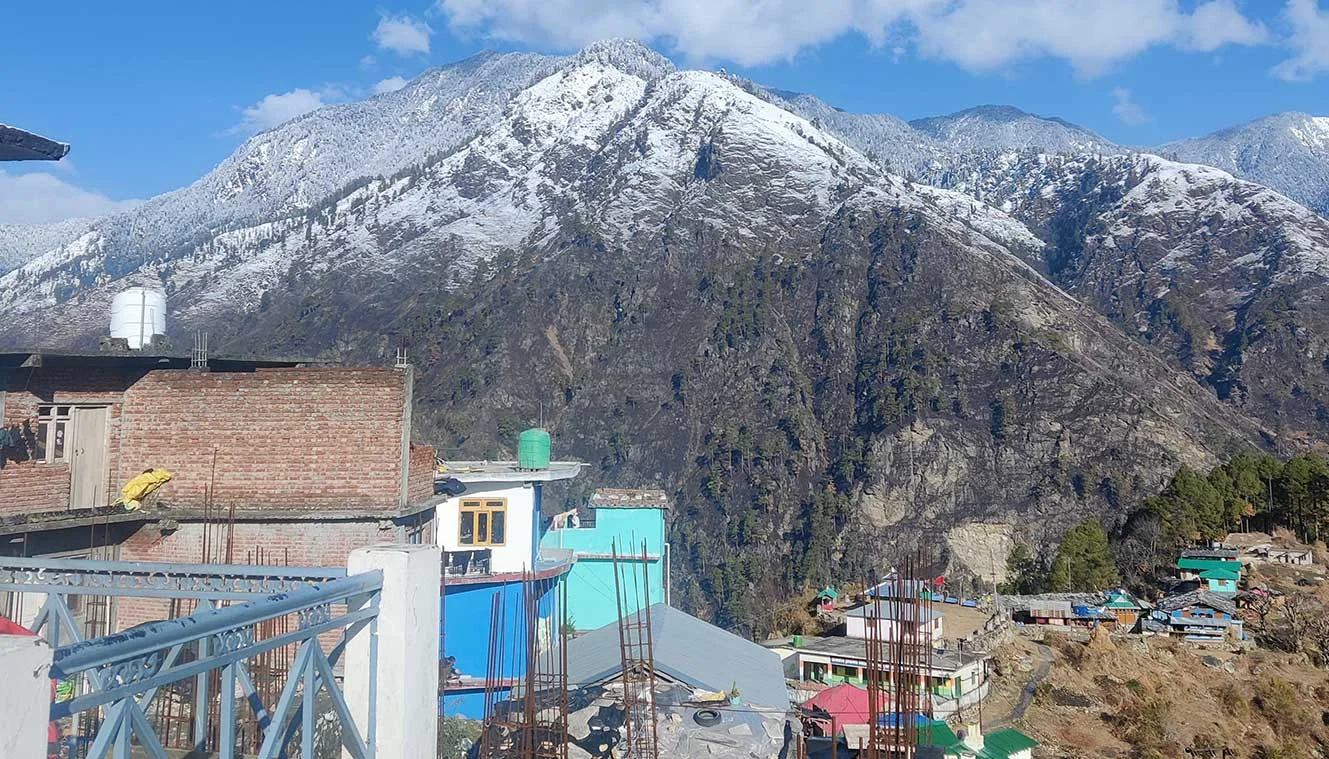
Day-1: Dehradun To Sankri | Start Your Journey Towards A Himalayan Paradise
- 220 km drive by NH 507 - approx 10 hrs.
- Altitude: 1,950 m/ 6,400 ft.
Day-2: Sankri To Pauni Garaat via Taluka | Witness Step Farming In The Himalayas
- Sankri To Taluka (Drive): 12 km, 1 hr.
- Altitude: Taluka - 2,200 m/ 7,200 ft; Pauni Garaat - 2,500 m/ 8,200 ft.
- Trek Distance: 10 km | Duration: 5-6 hrs.
- Altitude Gain: 550 m/ 1,800 ft.
Day-3: Pauni Garaat To Kalkattiyadhar | Pass By A 300-Year-Old Village
- Altitude: 3,000 m/ 9,850 ft.
- Trek: 8 km | Duration: 5 to 6 hr.
- Altitude Gain: 500 m/ 1,650 ft.
Day-4: Kalkattiyadhar To Har Ki Doon And Back To Kalkattiyadhar | Day Of Summit
- Altitude: 3,600 m/ 11,800 ft.
- Trek Distance: 10 km | DIstance: 9 hr.
Day-5: Kalkattiyadhar To Pauni Garaat Via Osla | Retreating Back
- Altitude: 2,500 m/ 8,200 ft.
- Trek Distance: 8 km | Duration: 5 hrs.
- Altitude Loss: 500 m/ 1,650 ft.
Day-6: Pauni Garaat To Sankri Via Taluka | Last Day Of Trekking
- Altitude: 1,950 m/ 6,400 ft.
- Trek Distance: 10 km | Duration: 5 hrs.
- Drive Distance: 12 km, 1 hr from Taluka to Sankri.
Day-7: Sankri To Dehradun | Saying Goodbye To The Mountains
- Distance: 220 km | Duration: 10 hrs approx.
- Driving Time: 7 am - 6 pm.
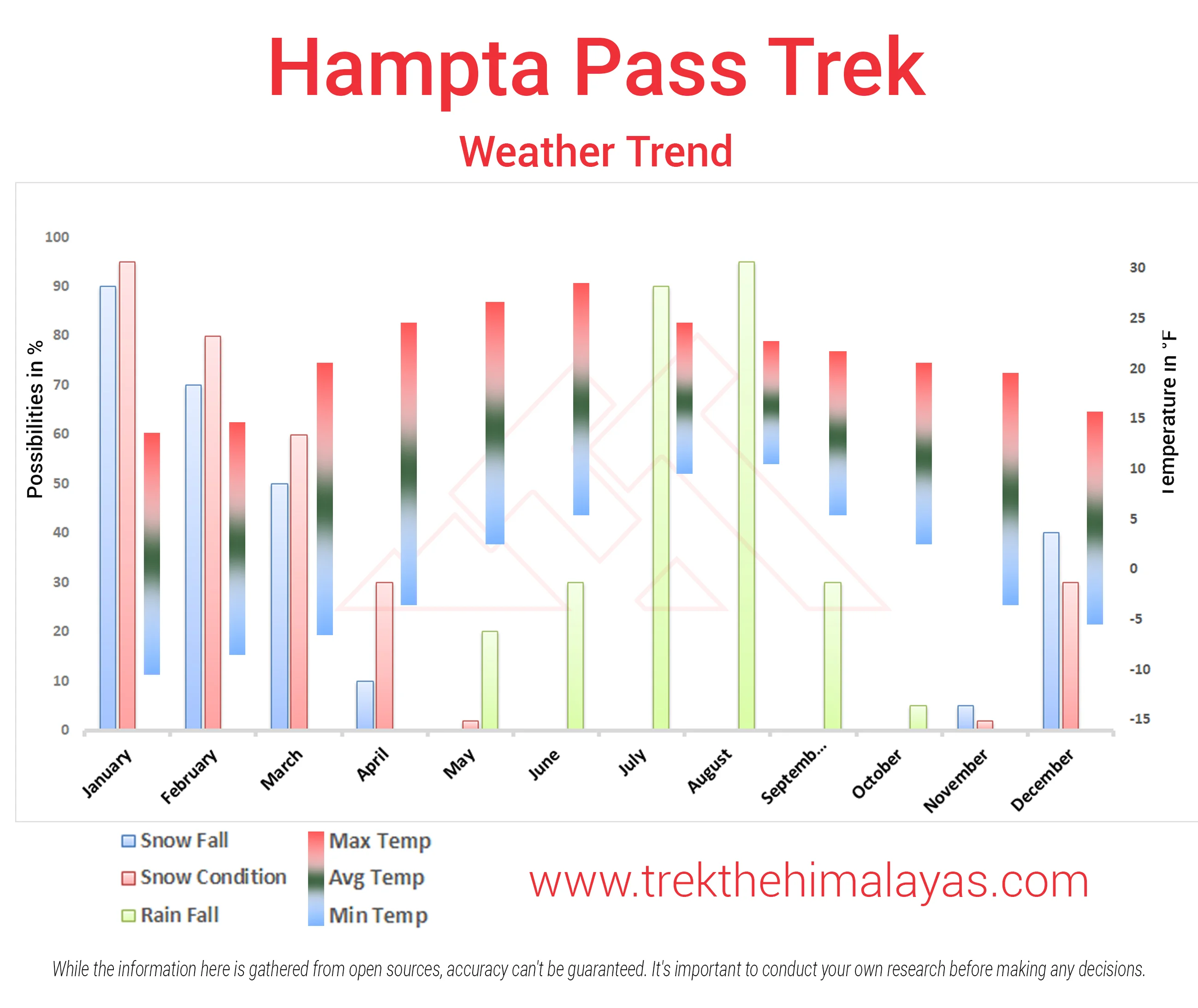
Important Links
Medical & Disclaimer Form (Mandatory Documents) Click Here.
How To Reach
It is essential for everyone to arrive at Dehradun (06:00 am).
Our pick-up location is Dehradun Railway Station at 06:00 AM
Once you have reached Dehradun, TTH will manage the rest of your travel arrangements, if you have opted for TTH's pick-up service, you can select this option during the booking process by adding it as an add-on.
The distance from the Dehradun Bus Stand (ISBT) to the Railway Station is 6 km, without traffic, it will take 15 minutes.
Note
- Transportation Amount is not included in the trek cost.
- Pick-up is excluded from the cost of the trek.
- TTH’s Tata Sumo, Tempo Traveller or similar vehicles will pick-up you.
- If you wish to upgrade the transport service, please contact the Trek Coordinator.
Options to reach Dehradun
1. Take an overnight train/bus to Dehradun, and then take a cab to the pickup point.
We always recommend to go for the govt. Buses over the private ones outside the bus station as based on the experience we have found that there are very high chances of delay involved with private buses. Also, govt. Buses are always more reliable. Whichever bus you choose, just make sure to reach Dehradun at least by 05:30 am positively.
2. Take flight to Dehradun airport (Jolly Grant Airport) (25 km, 50 min), if coming by flight then come one day early.
If you prefer to travel independently, you can either take a government bus or book a private cab. Your trek coordinator will provide guidance on how to arrange for the bus or cab booking.
Arrive in Dehradun Railway Station by 6:00 pm.
The designated drop-off point is Dehradun Railway station.
Please consider planning your subsequent travel arrangements after 8:00 pm.
The distance from Railway Station to Dehradun Bus Stand (ISBT) is 6 km, it will take approx 25 minutes.
The distance from Railway Station to Dehradun Airport is 28km, it will take approx 45min to 1hr.
TTH offers comfortable transportation through Tempo Traveler, Bolero, or equivalent vehicles. If you wish to upgrade your mode of transportation, please contact your trek coordinator for further assistance.
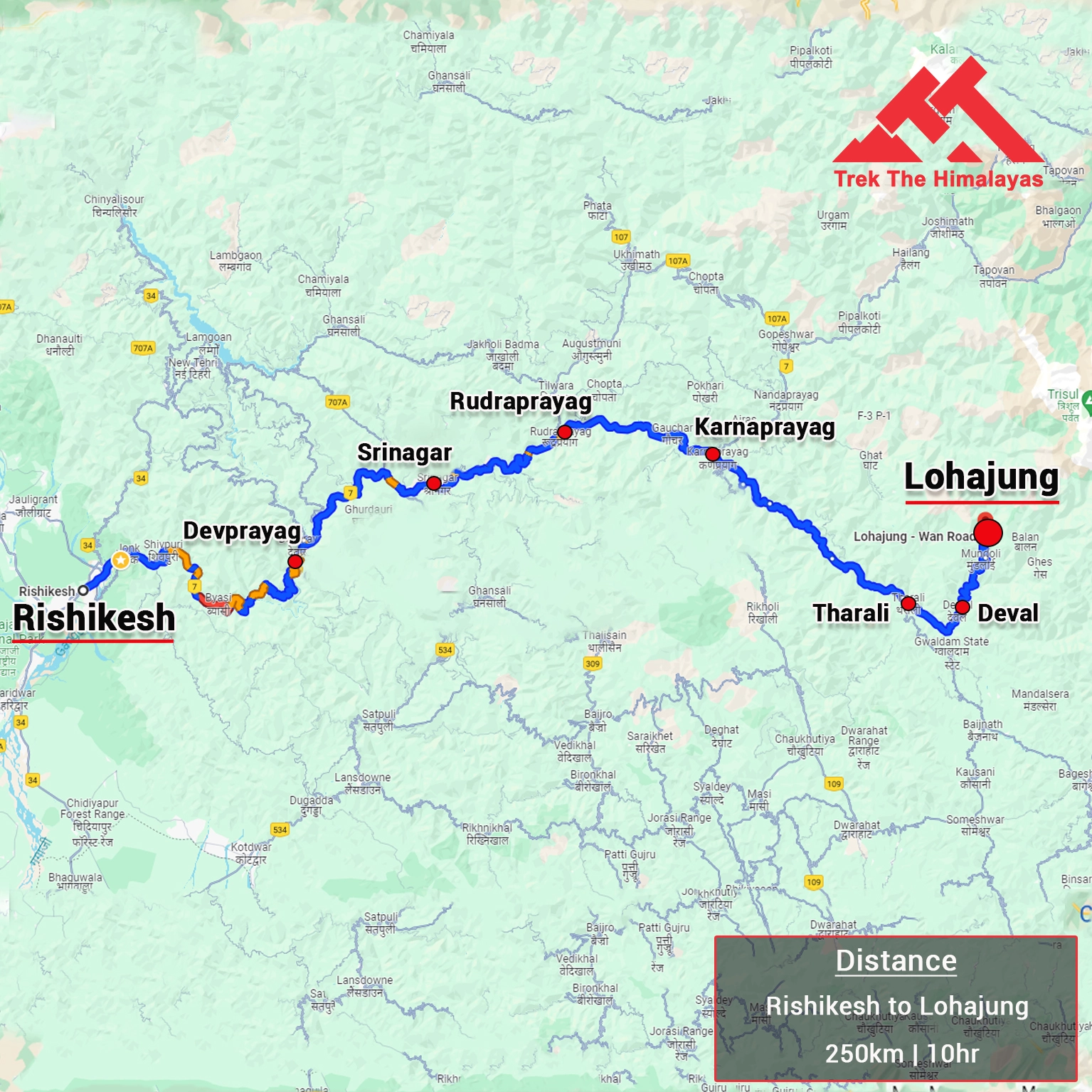
Cost Terms
Inclusion
1. Accommodation (as per the itinerary):
- Guest house, Home stay, camping during Trek.
2. Meals (Veg + Egg):
- Meals while on trek (Veg. + Egg).
3. Support:
- 1 Versatile base camp manager: handles communication and deploys extra manpower in emergencies.
- 1 Mountaineering & First aid qualified professional trek Leader.
- 1 Experienced high altitude chef.
- Local experienced guides (Number of guides depending on the group size).
- Enough support staff.
4. Trek equipment:
- Sleeping bag, Sleeping liners (if required), Mattress, Utensils.
- 3 men all season trekker tent (twin sharing), Kitchen & Dining tent, Toilet tent.
- Camping stool, Walkie talkie.
- Ropes, Helmet, Ice axe, Harness, Gaiters & Crampon (if required).
5. First aid:
- Medical kit, Stretcher, Oxygen cylinder, Blood pressure monitor, Oximeter, Stethoscope.
6. Transportation (as per the itinerary):
- Transport from Dehradun to Sankri and Return.
7. Mules/porters to carry the central luggage.
8. Clock room facility available at the base camp for additional luggage.
9. All necessary permits and entry fees, Upto the amount charged for Indian.
10. Services from Sankari to Sankari.
11. Transport cost.
Exclusion
1. Insurance (Mandatory).
2. Food during the transit.
3. Any kind of personal expenses.
4. Mule or porter to carry personal luggage.
5. Emergency evacuation, hospitalization charge or etc.
6. Anything not specifically mentioned under the head Inclusion.
Things can be provided on demand and availability (participant has to pay extra for these things).
1- Satellite phone/set phone - is a type of mobile phone that connects via radio links via satellites orbiting the Earth instead of terrestrial cell sites like cellphones. Therefore, they can operate in most geographic locations on the Earth's surface.
2- Gamow/PAC HAPO Bag (Portable Hyperbaric Bag) - is a unique, portable hyperbaric chamber for the treatment of acute mountain sickness (AMS), also known as altitude sickness.
3- AEDs (Automated External Defibrillators) - are portable life-saving devices designed to treat people experiencing sudden cardiac arrest, a medical condition in which the heart stops beating suddenly and unexpectedly.
Cancellation terms:
Cancellations prior to 25 days from the start of the Trip
Refund options
- 5% deduction of trek fee
- 100% cash voucher for any trip till one year
- Transfer your trek (any trek, any date) to your friend
Cancellation between 24 days and 15 days to the start of the Trip
Refund options
- 30% deduction of trek fee
- 100% cash voucher for same trip till one year
- 85% cash voucher for any trip till one year
- Transfer your trek (same trek, any date) to your friend
Cancellation between 14 days and 10 days to the start of the Trip
Refund options
- 50% deduction of trek fee
- 80% cash voucher for same trip till one year
- 70% cash voucher for any trip till one year
- Book the same trek, in the same season, with any other batch
- Transfer your trek (same trek, any date) to your friend
Cancellation less than 9 days to the start of the trek
Refund options
- No cash refund
- 20% cash voucher for the same trip till one year
- 10% cash voucher for any trip till one year
- Transfer your trek (same trek, same date) to your friend
Note- If a booking is made using a voucher or discount code, the policies related to vouchers and discounts cannot be modified.
In the unlikely event that TTH cancels a trek prior to the scheduled departure date:
While it is extremely rare for TTH to cancel a trek, we understand that unforeseen circumstances or natural disasters may occasionally require us to do so before the scheduled departure. These circumstances could include continuous rain or snow, thunderstorms, snowstorms, landslides, floods, earthquakes, or any other natural calamity that poses a risk to the safety of our trekkers. Additionally, unforeseeable events such as local riots, curfews, pandemics, lockdowns, government orders, or any similar situations that compromise the safety of the trekking experience may also necessitate a cancellation.
In the event of such a cancellation, TTH will provide you with a voucher equivalent to the amount you paid for the trek. This voucher can be redeemed for any of our treks within the next year, allowing you to still enjoy an adventure with us at a later date.
Note
-
The issuance of a voucher is not applicable in situations where you are required to descend from the trek for any reason. The trek leader may make the decision to send you down from the trek due to factors such as insufficient fitness level, symptoms of Acute Mountain Sickness (AMS), high blood pressure, exceeding the designated turn-around-time, health concerns, or if you are found smoking, drinking, or violating the rules set for the trek. In such cases, the provision of a voucher does not apply.
In the rare event that TTH shifts a trek:
We would like to emphasize that weather conditions in high-altitude areas are highly unpredictable and can undergo sudden changes at any time, irrespective of the day. Additionally, circumstances beyond our control, such as natural disasters, political unrest, pandemics, and lockdowns, may impact the feasibility of conducting a trek. In cases where we are unable to proceed with an event due to such circumstances that are beyond our direct control, we will make every effort to provide you with an alternative trek that is safer and more suitable.
In such situations, we will issue a voucher to offset the cost difference between the originally scheduled trek and the alternative trek. This voucher can be redeemed at any time within one year from the date of issue. Please note that a refund fee or reimbursement of the cost difference is not applicable in these cases.
Note:
- Change of trek batch is dependent on the availability of seats in the batch
- In case of transferring a trek to a friend, he/she should satisfy all the mandatory requirements put forward by TTH
- TTH holds the right to change/cancel the policies, without prior notice
- Cash refund is applicable only in case of bookings made without using any promotional offer code or vouchers
Cash Voucher Terms:
- This is a non-transferable voucher
- The voucher cannot be merged with any other offer of Trek The Himalayas
- The voucher is valid for Trek booked directly with Trek The Himalayas in India
- To avail the voucher please use your register phone number or e-mail id
- All the other Terms of booking a trek with Trek The Himalayas are applicable to the voucher
- Trek The Himalayas holds rights to add/remove any of the Terms and Conditions without prior notice
Itineraries are based on information available at the time of planning and are subject to change. "Trek The Himalayas" reserves the right to change expedition dates, people or itineraries as conditions warrant. If a trip must be delayed or the itinerary changed due to bad weather, road conditions, transportation delays, government intervention, airline schedules, sickness, or other contingency for which TTH or its agents cannot make provision, the cost of delays and/or other changes are the responsibility of the participant. TTH reserves the right to decline, or accept, any individual as a trip member for any reason whatsoever.
Trek Essentials
PDF Of Trek Essential Download
| Backpack with rain cover | (50 - 60 ltr) with comfortable shoulder straps |
| Day pack with rain cover | 20 - 30 ltr (If off-load opted) |
| Walking stick | Advisable (At least one) |
| Water Bottle / Hydration pack | 2 bottles of one liter each, People who use hydration pack 1 hydration pack and 1 bottle of one liter, Carry at least one thermos flask. |
| Small size tiffin/lunch box | 1 Nos |
| Snacks | Energy bars, dry fruits, electoral/ors |
| Personal Medical Kit | Consult your doctor |
| T-Shirt (Synthetic quick dry) | 1 Full & 2 Half sleeves |
| Fleece T-shirt | 1 Nos |
| Wind stopper / Fleece jacket | 1 Nos |
| Windproof Jacket | 1 Nos |
| Down feather / Hollow jacket | 1 Nos |
| Thermal inner (Upper and Lower) | 1 Pair |
| Trek Pant (Synthetic quick dry) | 2 Nos |
| Wind stopper / Fleece Pant | 1 Nos |
| Waterproof gloves | 1 Pair |
| Fleece / woollen gloves | 1 Pair |
| Poncho / waterproof Jacket and pant | 1 Nos |
| Sunscreen | 1 Nos |
| Moisturiser | 1 Nos |
| Chap-stick / Lip balm | 1 Nos |
| Toothbrush and toothpaste | 1 Nos |
| Toilet paper & Wipes | 1 Nos |
| Soap / hand sanitizers | 1 Nos |
| Antibacterial powder | 1 Nos |
| Quick dry towel | 1 Nos |
| Head torch | 1 Nos. (Avoid Hand torch) |
| Sun Cap | 1 Nos |
| Woolen cap | 1 Nos. |
| Balaclava | 1 Nos. |
| Buff / Neck-gaiters | 1 Synthetic & 1 Woollen |
| Sunglasses | UV with dark side cover, People who wear spectacles - (A)- Use contact lenses | (B)- Photo chromatic glasses |
| Trekking shoes | 1 Pair (Waterproof, high ankle, good grip) |
| Floaters / flip-flops | 1 Pair |
| Cotton socks | 6 pairs |
| Woollen socks | 1 pairs |
| Gaiters | 1 Pair (TTH provides when required) |
| Micro spikes | 1 Pair (TTH provides when required) |

Frequently Asked Questions(FAQ)
To register with TTH, visit our website - www.trekthehimalayas.com and create your account. To create your account you will need to use your email address and fill in all the details, set your unique password and your account is ready to use.
- To book a trek with TTH, you first need to register with us and create an account.
- Choose the trek that you want to do and click on available dates.
- You will land at the login page, fill in the required details.
- Add Participants, choose add-on services click on the Pay now button, choose your preferred payment method, and make the payment. TTH accepts multiple payment options, including credit/debit cards, net banking, and UPI.
- You will receive a confirmation email from TTH with all the necessary details about the trek, including the meeting point, transportation, accommodation, and other important instructions.
please send an email to us at info@trekthehimalayas.com or reach out to the numbers provided in the Help and Support section of your Trek Page. We will ensure that your issue is promptly resolved.
To book services such as off-load luggage and transportation, you can find them listed as add-ons. These additional services can be booked at the time of your initial booking. If you miss booking add-ons during the initial reservation, you can log in anytime and easily book 4 days before the departure date add-ons through the platform.
In such a situation, please log in to your account and transfer your trek or date to the desired one within 12 hours or drop us an email at info@trekthehimalayas.com 10 days before the departure date of the trek. After the initial 12-hour period, any changes will be processed according to the cancellation policy.
We recommend visiting our "Suggest Me a Trek" page. By filling out the form, our experts will contact you with the best possible trek options based on your preferences and experience level. Alternatively, you can reach out to us via email at info@trekthehimalayas.com or give us a call using the numbers provided on our website for personalized assistance and recommendations.
Family treks differ from regular treks by focusing on ease of difficulty, offering shorter durations for younger participants, Kid-friendly and easily digestible foods, child-friendly activities, maintaining a higher guide ratio for diverse age groups, and implementing additional safety measures for families.
Family Trek with Kids recommendation Only Dayara Bugyal and Chopta Chandrashila Trek.
Minimum age for TTH treks is typically 7 years, though this may vary depending on the specific trek.
Yes, you can take a kids to a high-altitude trek with a parent. Discuss with a trek expert before booking a trek.
Junior trekkers (below 15 years) should have a company of parents/guardians.
Trekkers between 15 to 18 years can come solo with the disclaimer form signed by parent/guardian.
Medical & Disclaimer Form (Mandatory Documents) Click here to download medical and disclaimer form
Physical Fitness: Ensure your child is physically fit. Engage them in regular exercise, outdoor activities, and hikes to build stamina and endurance. Hydration: Emphasize the importance of staying hydrated at high altitudes. Encourage your child to drink water regularly, even if they don't feel thirsty. Proper Nutrition: Provide a well-balanced diet with sufficient carbohydrates for energy and foods rich in iron to prevent altitude sickness. Adequate Sleep: Ensure your child gets enough sleep in the days leading up to the trek. Quality rest is crucial for altitude adaptation. Educate on Altitude Sickness: Teach your child about the symptoms of altitude sickness, such as headache, nausea, and dizziness. Encourage them to communicate any discomfort immediately. Appropriate Clothing and Gear: Dress your child in layers to adjust to changing temperatures. Ensure they have appropriate trekking gear, including sturdy footwear. Positive Mindset: Foster a positive mindset. Encourage your child, and let them know it's okay to take breaks when needed. Medical Check-Up: Schedule a medical check-up before the trek to ensure your child is fit for high-altitude activities. Consult with a healthcare professional about any potential health concerns.
TTH takes special care to provide wholesome and nutritious food for children on treks. Here are some of the foods that are typically served for children:
Breakfast: For breakfast, TTH serves a variety of options like porridge, cornflakes, bread, butter, jam, honey, boiled eggs, omelettes, and pancakes. Children can choose from these options to fuel themselves for the day's trek.
Lunch: For lunch, TTH serves lunch which includes rotis, vegetables, rice, dal, and salad. The rotis are usually made fresh on the trek and are a good source of carbohydrates. The dal and vegetables provide protein and other essential nutrients.
Snacks: TTH provides healthy snacks like fresh fruits, dry fruits, energy bars, cookies, and biscuits to keep the children energized throughout the day.
Dinner: For dinner, TTH serves a hot and wholesome meal which includes soup, rice, dal, vegetables, and a non-vegetarian dish (if requested in advance). Children can also choose from a variety of desserts like custard, jelly, and fruit salad.
Dietary requirements: If a child has any special dietary requirements, TTH can cater to those needs as well. For example, if a child is lactose intolerant or allergic to nuts, the kitchen staff can make arrangements to accommodate those requirements.
Choosing the right trek for a beginner can be a bit overwhelming as there are many factors to consider such as distance, elevation gain, terrain difficulty, weather, and time of year. Here are some tips that can help you choose the right trek for a beginner:
1. Determine fitness level: Assess the fitness level of the beginner to understand their physical capabilities. This will help you select a trek that is challenging but not too difficult.
2. Choose a well-traveled trail: A well-traveled trail will have more amenities such as signposts, water stations, and shelter. It is also safer as there will be other hikers on the trail.
3. Consider the length of the trek: For beginners, it is recommended to start with a shorter trek that can be completed in a day or two. This will help them get acclimatized to trekking and build their confidence.
4. Look for gradual elevation gain: Choose a trek with a gradual elevation gain rather than steep ascents. This will make the trek easier and more enjoyable.
5. Check the weather: Check the weather forecast before selecting a trek. Avoid treks during the monsoon season or winter when the trails can be slippery or dangerous.
6. Research the trail: Read about the trail to get an idea of the terrain, altitude, and difficulty level. This will help you select a trek that is suitable for the beginner.
7. Consult with an expert: If you are unsure about which trek to choose, consult our trek expert Mr. Nitin (+91 70600 59773) between 10 AM to 6 PM (Tuesday - Friday). Mr. Nitin will provide you valuable advice and guidance.
Overall, it is important to choose a trek that is enjoyable, challenging but not too difficult, and suitable for the beginner's fitness level and experience.
It is not recommended for a beginner to choose a difficult Himalayan trek. Trekking in the Himalayas can be physically and mentally challenging, especially if you are not used to the high altitude, steep slopes, and rugged terrain. Choosing a difficult trek without the proper experience, fitness level, and preparation can be dangerous and put you at risk of altitude sickness, injury, and other hazards.
If you are a beginner, it is recommended to start with an easier trek and gradually build up your skills and experience. This will help you understand the challenges of trekking in the Himalayas, and also prepare you physically and mentally for a more difficult trek in the future. It is also important to choose a trek that matches your fitness level, experience, and interest.
There is no specific age limit for a beginner trekker. However, it is important to consider your physical fitness, health condition, and personal interests before embarking on a trek. Trekking in the Himalayas can be physically and mentally demanding, and requires a certain level of physical fitness and endurance.
If you have any pre-existing medical conditions or are above a certain age, it is recommended to consult with a doctor before embarking on a trek. It is also important to listen to your body and take breaks as needed during the trek to prevent exhaustion or injury.
We recommend visiting our "Suggest Me a Trek" page. By filling out the form, our experts will contact you with the best possible trek options based on your preferences and experience level. Alternatively, you can reach out to us via email at info@trekthehimalayas.com or give us a call using the numbers provided on our website for personalized assistance and recommendations.
Yes, you can join the trek. We have fixed departure groups where you can simply book your trek and we will take care of curating a group.
Before you start the trek, it is recommended that you make all the necessary phone calls as during the trek you may or may not receive network coverage, once you come back to the Base Camp, you can reconnect with your family via phone once again. You can share your trek coordinator contact detail with your family members to get the latest updates about your trek batch.
At TTH, we provide wholesome and nutritious meals during the trek. The food is vegetarian and includes a variety of dishes such as rice, dal, vegetables, chapati, paratha, pasta, noodles, and soup. We also offer snacks such as biscuits, and salty, and dry fruits during the trek. Special dietary requirements such as vegan, gluten-free, or Jain food can also be arranged if informed in advance.
If you are allergic to some foods, you need to let us know in advance so that we can make arrangements accordingly.
TTH is a trekking company that prioritizes the safety of all its participants, including women trekkers. They have a comprehensive safety system in place, which includes a dedicated team of experienced and trained trek leaders and support staff who are equipped to handle emergency situations and provide first aid.
TTH also takes specific measures to ensure the safety and comfort of women trekkers. They have a separate tent accommodation for women trekkers, female trek leaders, and support staff. They also provide separate toilet facilities for women and encourage a safe and respectful environment for all trekkers.
Moreover, TTH has a strict policy against any kind of harassment and has a zero-tolerance policy towards such incidents. They have a designated Internal Complaints Committee (ICC) to investigate and address any complaints related to harassment or misconduct. Overall, TTH has a good reputation for safety and responsible trekking practices, and women can feel comfortable and safe while trekking with them.
In case you are the only women in the group, we provide a single sleeping arrangement. Also, during the trek, the trek leader will always remain by your side to provide optimum safety and reassurance.
You can reach out to the trek coordinator to inquire about the number of female trekkers and their respective states who have booked the trek. Please note that the trek coordinator cannot disclose personal details of any trekker. Once you've confirmed your booking, a WhatsApp Group will be created for all the trekkers in your batch. This allows you to connect with fellow trekkers before the trek begins.
While many of our treks are led by female trek leaders, however, it is not possible to know which trek leader is assigned to which group. But nonetheless, whether the trek leader is male or female you can be completely assured of your safety and security with us.
Yes, it is possible to trek with periods. However, it is important to take some extra precautions and preparations to ensure a comfortable and safe trekking experience.
Here are some tips that can help you trek during your period:
1. Use menstrual hygiene products that you are comfortable with, such as tampons, pads, or menstrual cups. It is recommended to carry enough supplies for the entire duration of the trek.
2. Pack wet wipes, hand sanitizer, and plastic bags to dispose of used hygiene products.
3. Wear comfortable and breathable clothing that allows for easy movement and reduces friction. Avoid wearing tight or restrictive clothing that can cause discomfort.
4. Carry pain relief medication, such as ibuprofen or acetaminophen, in case of menstrual cramps.
5. Stay hydrated and maintain a balanced diet to support your energy levels and overall health.
6. Take breaks as needed and listen to your body. If you feel uncomfortable or experience any unusual symptoms, seek medical attention immediately.
It is also recommended to consult with a doctor before going on a trek during your period, especially if you have a pre-existing medical condition or are taking medication. By taking necessary precautions and being prepared, you can have a safe and comfortable trekking experience even during your period.
We provide proper disposal facilities for sanitary pad disposal during the trek.
We offer three person tents with twin-sharing for optimum comfort. A woman trekker will share a tent with another woman trekker and if you are the only woman in the group, you will be given a single accommodation for your comfort and privacy.
Yes, we do provide gears on rent. You can book it using you TTH account directly.
Mountaineering qualified Experienced and first aid certified Trek Leader, First Aid Certify local guide, Cook, helpers and supporting staff.
People suffering from Bronchitis, Asthma, High blood pressure, Epilepsy (got faints), TB , Heart problem or on higher BMI side are strictly not allowed to go on any Himalayan trek. Apart from this if you had any medical history, please let us know.
No. Alcohol and smocking isn’t allowed while on trek. It is totally misconception that it will keep you warm. Your body need to acclimatize properly and for that eat properly and drink enough water; these things will keep you warm.
Toilet tents provide a convenient solution for answering nature's call in the great outdoors. Dry toilets, in particular, offer a highly sanitary approach. By digging a pit and utilizing mud and a shovel, you can easily cover up your waste. This method ensures cleanliness and hygiene while camping or exploring in the forest.
Remember to pack essential toiletries to complete your outdoor bathroom kit and maintain proper personal hygiene during your adventures. With these practices in place, you can enjoy nature while also respecting it.
Layer Up From Head To Toe
Eat Full Meals, never sleep empty stomach
You can keep warmee (if you’re more susceptible to cold).
Use sleeping bag in right way and don’t leave free space in sleeping bag.
For upper body
– Thermal layer
– T-shirt (full-sleeves)
– Fleece T-shirt (for extreme colds)
– Fleece layer
– Thick Jacket/Down Jacket
– Waterproof or Windproof layer (outermost layer, when it is snowing or raining)
- For Lower Body
– Thermal layer
– Hiking pants (normal) or Winter hiking pants
Based on how warm you feel you can skip any of the above layers. Your outer later should be windproof since it is windy at high altitude.
The idea behind layering is that the more insulation you have the less cold you feel, and instead of wearing a very thick jacket if you wear multiple layers, your body will be better insulated against the cold.
Yes, we provide micro spikes and gaiters, if required.
Mandatory documents: 2 xerox of ID having address (addhar card/driving license), 2 Passport size photographs, hard copy Medical form signed & sealed by doctor, disclaimer form sign by trekker and high altitude insurance.
No. We don’t but we can suggest you good hotel/Stay nearby pick up location.
Yes, trekker must carry 2 water bottles 1 litre each so they can refill it at campsite for drinking and keep themselves hydrate.
You should buy shoes which has these three features –Good grip, Ankle Support and additional water resistant layers. Generally, we advise Quechua Trek 100, MH 500 and MH 100.
Your return transport is also included in trek fee if you're opting for service Dehradun to Dehradun ; we use Tempo Traveller/ Tata Sumo/Max/Boloero kind of vehicle.
No one is forced to go on. There is always enough staff to split the party according to need and regroup later at the camp. Most people have no trouble reaching the highest campsite. If some members decide not to climb the final distance they can wait for the climbers to come back down the same way or take a lateral path to the descent route.
We always have a first aid kit close at hand. Serious injuries are rare. Porters will assist injured climbers to the base of the mountain and onward to a clinic or hospital. Kilimanjaro International Airport is very near Marangu Gate if evacuation to the US or Europe is advisable.
The Har Ki Dun Trek is a popular trekking expedition in the Indian state of Uttarakhand, which takes you through the scenic landscape of the Garhwal Himalayas and offers stunning views of the mountains and valleys.
The Har Ki Dun Trek typically takes around 6-7 days to complete, depending on the route and weather conditions.
The best time to do the Har Ki Dun Trek is from mid-April to mid-June and from mid-September to mid-November when the weather is relatively stable and the snow has melted, making the trek less difficult.
No, previous trekking experience is not necessary for the Har Ki Dun Trek, but a good level of fitness is required due to the steep and rocky terrain.
The Har Ki Dun Trek requires a moderate level of physical fitness as the trek involves moderate ascents and descents, rocky terrain, and potential altitude sickness. It is recommended to undergo physical training and preparation before attempting the trek.
To undertake the Har Ki Dun Trek, you will need to obtain the necessary permits and paperwork from the Forest Department and the local authorities. These may include a trekking permit and a medical certificate. It is recommended to research the specific requirements and apply for the permits well in advance to avoid any delays or issues.
The highest point of the Har Ki Dun Trek is the Har Ki Doon Pass, which stands at an altitude of 3,566 meters (11,700 feet).
Yes, the Har Ki Dun Trek is generally considered safe, but with any trek, there are inherent risks involved. It is important to follow safety guidelines, such as staying hydrated, wearing appropriate clothing and footwear, and avoiding overexertion.
Accommodation on the Har Ki Dun Trek typically includes camping in tents, sleeping bags, camping equipment, or basic lodges.
The Har Ki Dun Trek is considered to be a moderate trek due to its moderate ascents and descents, rocky terrain, and potential for altitude sickness.
It is recommended to do the Har Ki Dun Trek with a certified guide or trekking agency for safety reasons, but it is possible to do it solo if you have previous trekking experience and the necessary equipment and permits.
The distance covered on the Har Ki Dun Trek is approximately 44-48 kilometers (34-37 miles), depending on the route taken.
The altitude sickness risk on the Har Ki Dun Trek is generally considered to be low to moderate. The highest point reached on the trek is approximately 12,000 feet (3,658 meters) at the Har Ki Doon Valley. This altitude is relatively moderate and usually does not pose significant altitude-related challenges for most trekkers. However, individual susceptibility to altitude sickness can vary, and it's important to take necessary precautions such as acclimatizing properly, maintaining a gradual ascent, staying hydrated, and listening to your body for any signs of altitude sickness. It is always recommended to consult with a medical professional before undertaking any high-altitude trek.
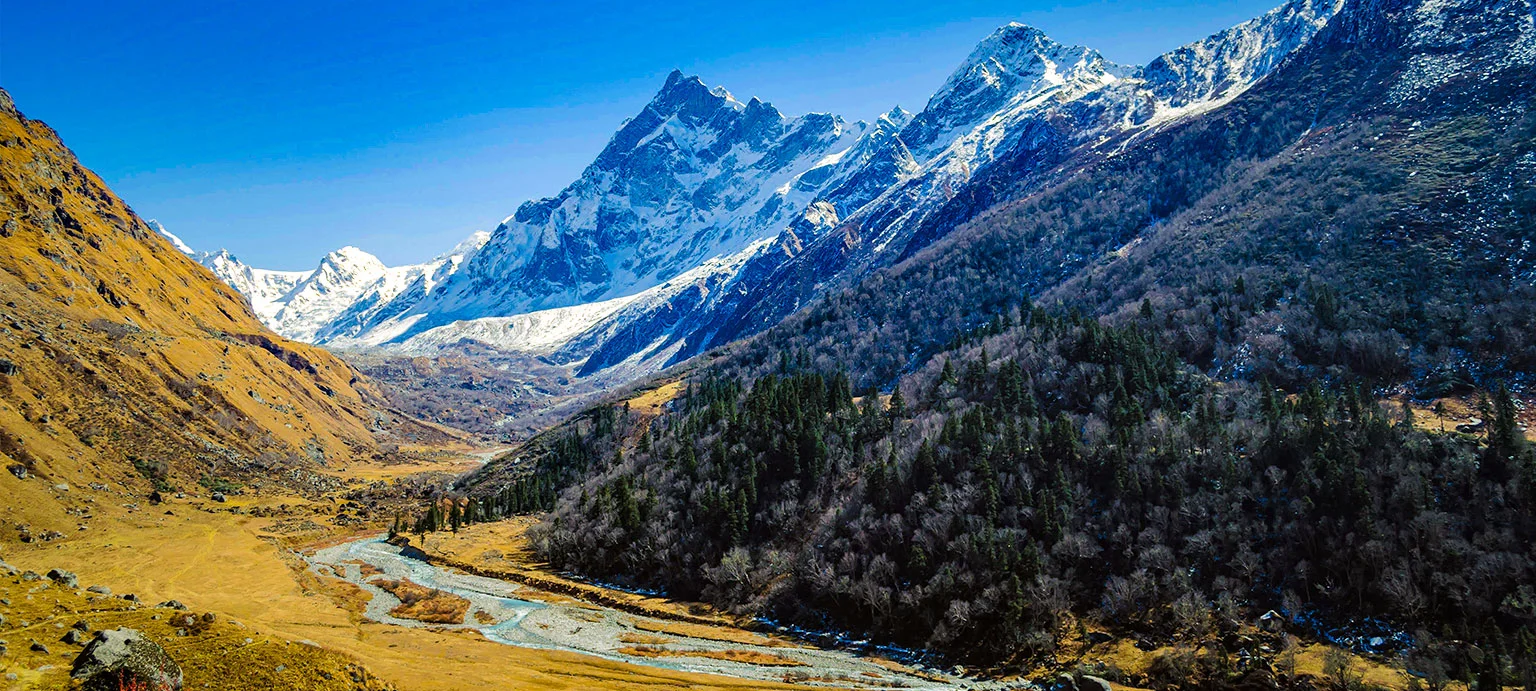
.webp)